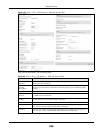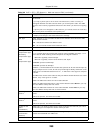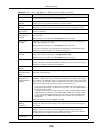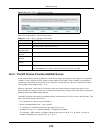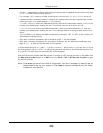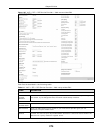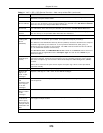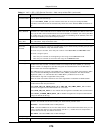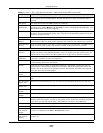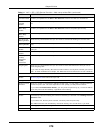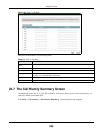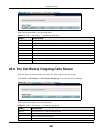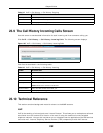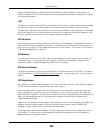
Chapter 23 Voice
VMG5313-B10A/-B30A Series User’s Guide
276
Bound
Interface Name
If you select LAN or Any_WAN, the VMG automatically activates the VoIP service when any
LAN or WAN connection is up.
If you select Multi_WAN, you also need to select two or more pre-configured WAN
interfaces. The VoIP service is activated only when one of the selected WAN connections is
up.
Outbound Proxy
Outbound
Proxy Address
Enter the IP address or domain name of the SIP outbound proxy server if your VoIP service
provider has a SIP outbound server to handle voice calls. This allows the VMG to work with
any type of NAT router and eliminates the need for STUN or a SIP ALG. Turn off any SIP ALG
on a NAT router in front of the VMG to keep it from re-translating the IP address (since this
is already handled by the outbound proxy server).
Outbound
Proxy Port
Enter the SIP outbound proxy server’s listening port, if your VoIP service provider gave you
one. Otherwise, keep the default value.
RTP Port Range
Start Port
End Port
Enter the listening port number(s) for RTP traffic, if your VoIP service provider gave you this
information. Otherwise, keep the default values.
To enter one port number, enter the port number in the Start Port and End Port fields.
To enter a range of ports,
• enter the port number at the beginning of the range in the Start Port field.
• enter the port number at the end of the range in the End Port field.
SRTP Support
SRTP Support
When you make a VoIP call using SIP, the Real-time Transport Protocol (RTP) is used to
handle voice data transfer. The Secure Real-time Transport Protocol (SRTP) is a security
profile of RTP. It is designed to provide encryption and authentication for the RTP data in
both unicast and multicast applications.
The VMG supports encryption using AES with a 128-bit key. To protect data integrity, SRTP
uses a Hash-based Message Authentication Code (HMAC) calculation with Secure Hash
Algorithm (SHA)-1 to authenticate data. HMAC SHA-1 produces a 80 or 32-bit
authentication tag that is appended to the packet.
Both the caller and callee should use the same algorithms to establish an SRTP session.
Crypto Suite
Select the encryption and authentication algorithm set used by the VMG to set up an SRTP
media session with the peer device.
Select AES_CM_128_HMAC_SHA1_80 or AES_CM_128_HMAC_SHA1_32 to enable
both data encryption and authentication for voice data.
Select AES_CM_128_NULL to use 128-bit data encryption but disable data authentication.
Select NULL_CIPHER_HMAC_SHA1_80 to disable encryption but require authentication
using the default 80-bit tag.
DTMF Mode
DTMF Mode
Control how the VMG handles the tones that your telephone makes when you push its
buttons. You should use the same mode your VoIP service provider uses.
RFC2833 - send the DTMF tones in RTP packets.
PCM - send the DTMF tones in the voice data stream. This method works best when you are
using a codec that does not use compression (like G.711). Codecs that use compression
(like G.729 and G.726) can distort the tones.
SIP INFO - send the DTMF tones in SIP messages.
Transport Type
Transport Type
Select the transport layer protocol UDP or TCP (usually UDP) used for SIP.
Table 111 VoIP > SIP > SIP Service Provider > Add new provider/Edit (continued)
LABEL DESCRIPTION



